
The Equitable Education Fund (EEF) Thailand joins the Asia-Pacific Meeting on Education to Accelerate Learning for a Sustainable Future.
The Equitable Education Fund (EEF) Thailand participated in the 6th Asia-Pacific Meeting on Education 2030 (APMED6) under the theme “Accelerating Actions: Transforming the What and How of Learning for a Sustainable Future.” The event took place from 10-13 September 2024 at the Bangkok Marriott Marquis Queen’s Park Hotel. UNESCO’s Bangkok Regional Office organized it in collaboration with UNICEF’s East Asia and Pacific Regional Office (EAPRO), South Asia Regional Office (ROSA), the United Nations, and the Government of Japan’s Ministry of Education, Culture, Sports, Science, and Technology (MEXT), convened under the Asia-Pacific Learning and Education 2030+ (LE2030+) Network Group.
The four-day meeting brought together representatives from various countries, including officials from Ministries of Education, SDG 4 international coordinators, social development and human security officers, national and regional educational institutions, international regional and sub-regional organizations, national and regional civil society organizations (NGO/CSO), youth representatives, and UN agencies from 46 UNESCO member countries in the Asia-Pacific region, as well as those involved in education both within and outside the Asia-Pacific. Over 150 participants attended to assess progress toward Sustainable Development Goal (SDG) 4* and explore model practices. Discussions focused on addressing the learning crisis, promoting inclusive lifelong learning, and advancing early childhood education for young people in the Asia-Pacific region. These are key elements in transforming education for a sustainable future.
*The Sustainable Development Goals (SDGs) consist of 17 development goals endorsed by 193 United Nations member countries. These goals provide a global development framework that all countries must collectively work towards, aiming to achieve them within 15 years (2016-2030). Goal 4 focuses on ensuring inclusive and equitable quality education for all while promoting lifelong learning opportunities.

At the opening session, representatives from various sectors emphasized the key issue of APMED 6, which focused on the “learning crisis.” Despite significant progress in expanding access to education in the Asia-Pacific region over the past decade, evidenced by an increase in the number of students in formal education, many children and youth remain outside the system. In terms of learning outcomes, data indicate that nearly 50% of students in primary and lower secondary levels across about half of the region’s countries are unable to improve their basic reading, writing, and math skills. According to the latest PISA assessments from 2018 to 2022, the overall development of these skills among 15-year-old students has shown a declining trend.
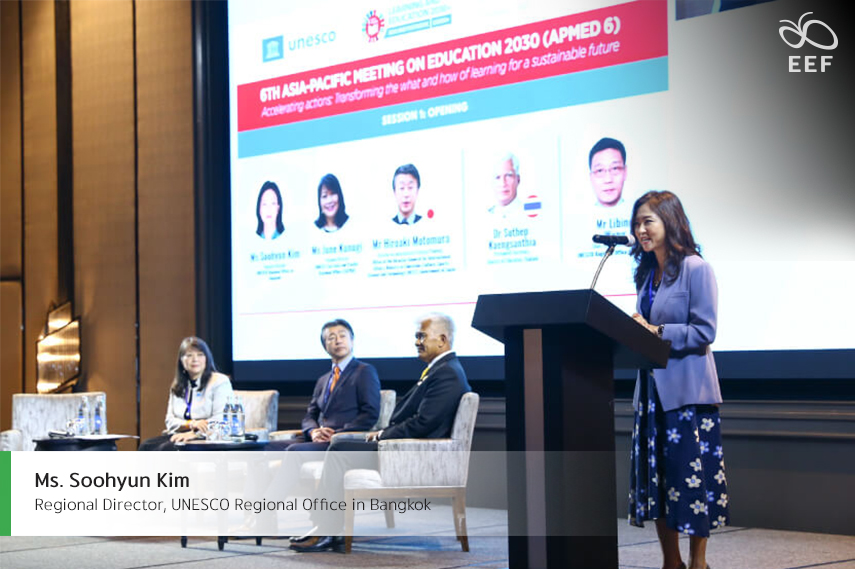
Ms. Soohyun Kim, Director of UNESCO Bangkok Regional Director, UNESCO Regional Office in Bangkok, stated that the results indicating more than half of primary and lower secondary students have reading and math skills below the required standard, along with the statistic showing that less than 40% of youth in each cohort complete upper secondary education, highlight the urgent need to promote equitable access to quality education. This access is essential for fostering peace and achieving progress through the efficient use of resources. She emphasized the importance of increasing the number of “happy schools” and creating a learning ecosystem that enhances academic achievement while improving students’ well-being.
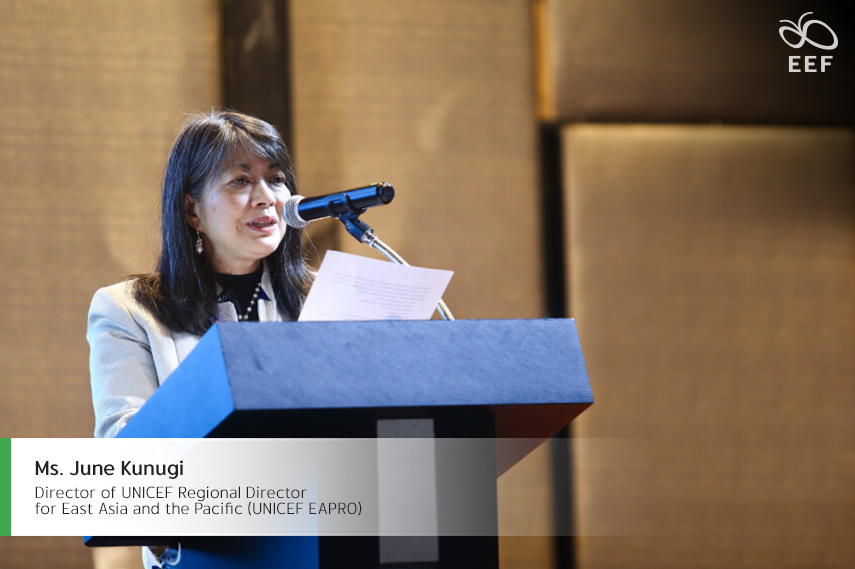
Ms. June Kunugi, Director of UNICEF East Asia and Pacific UNICEF Regional Director for East Asia and the Pacific (UNICEF EAPRO), stated that the COVID-19 pandemic has caused a severe crisis in the quality of education. Many education systems in the region have struggled to meet the learning and training needs of students, communities, and countries. This challenge is particularly acute in the current context, where all nations face economic and social issues such as labor market shifts and environmental challenges like climate change, significantly impacting students and education management. Education systems need to be more responsive to everyday realities while anticipating future changes.
“The COVID-19 pandemic has left long-lasting impacts, resulting in learning regressions for some students in the Asia-Pacific region, necessitating urgent measures to create access to learning opportunities for vulnerable children and youth. This includes those affected by poverty, geographic isolation, ethnic and linguistic minority status, disabilities, and those impacted by conflicts, disasters, environmental degradation, and climate change. Many children and youth, even while still in school, are learning below standard levels. Currently, a significant number of young people struggle with reading, writing, and understanding basic concepts. Data shows that about 6 out of 10 children aged 10 in South Asia cannot read and comprehend simple texts in their language, adversely affecting their learning in other areas. This represents a lost opportunity for these children and youth and poses a significant setback for countries seeking a workforce to develop their economies and societies in the future. On behalf of UNICEF, we urge the governments of countries in the Asia-Pacific region to expedite their commitments to the Convention on the Rights of the Child by ensuring that all children have access to quality, inclusive, and safe education, particularly during early childhood and compulsory education.”
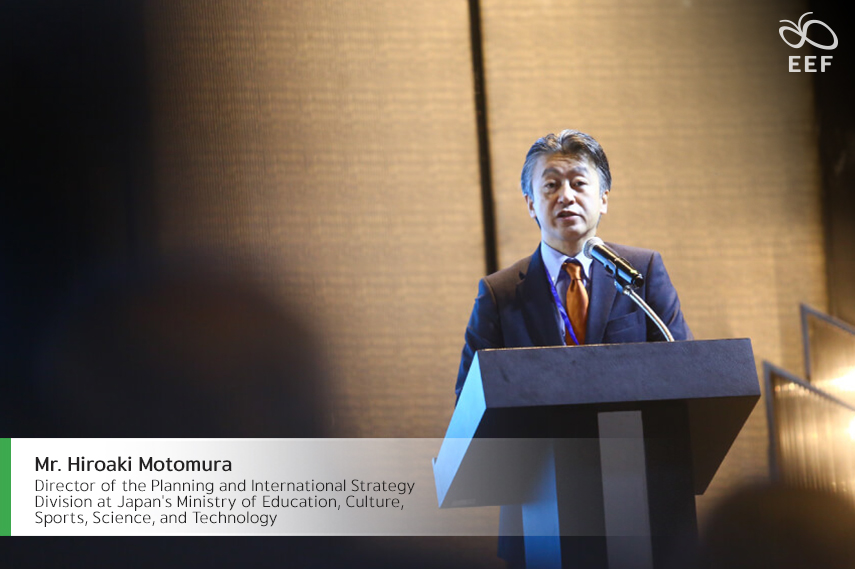
Mr. Hiroaki Motomura, Director of the Planning and International Strategy Division at Japan’s Ministry of Education, Culture, Sports, Science, and Technology, discussed the response to the post-COVID-19 period, stating, “Japan has been making efforts to adapt quickly after the COVID-19 situation by incorporating digital tools as a crucial part of learning. We are reducing disparities in access to these tools and ensuring continuous learning through remote and hybrid education, which prepares us for potential crises or disasters that may arise in the future. Moreover, hybrid learning also allows vulnerable populations to access learning opportunities more comprehensively.”
Mr. Hiroaki emphasized the importance of regional and international cooperation, stating that supporting collaboration is a key mechanism for addressing the education crisis. He called on education professionals from various countries to sign and take action to affirm their commitment to improving basic learning for children and youth. He proposed increasing public funding for pre-primary and primary education by an additional 10% to support long-term development.
This proposal aligns with data showing that investment in education in the Asia-Pacific region is very low compared to other regions worldwide. Surveys indicate that education expenditures in the Asia-Pacific have decreased in almost all sub-regions. For instance, in East Asia and Southeast Asia, education spending fell from 15.41% of total public expenditure to 13.87%. This decline means that the Asia-Pacific region’s educational investments fall below the international benchmark of 15% of total public expenditure. Additionally, the limited budget and resources for education have not been allocated effectively, resulting in inadequate improvements in learning management operations.
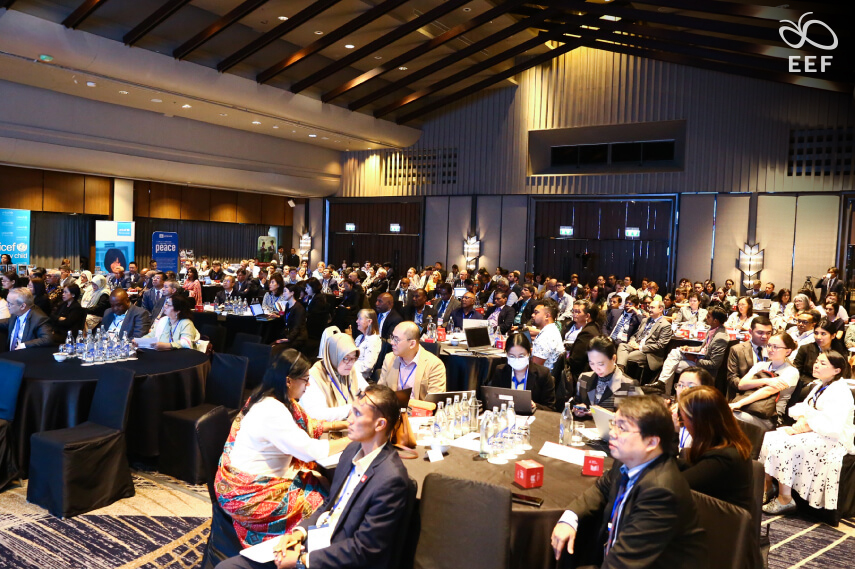
The APMED 6 meeting aims to accelerate the achievement of SDG 4 goals in the region and address the current learning crisis. A key focus of the meeting is to monitor the actions of governments and stakeholders in education within the Asia-Pacific region, taking into account the ongoing educational challenges. The goal of SDG 4, which emphasizes “inclusive and equitable quality education and lifelong learning opportunities for all,” must include creating equitable access to quality education from early childhood through compulsory education, leading to effective learning outcomes. This also extends to promoting access to quality technical, vocational, and higher education at affordable prices to increase the skilled labor force and foster new entrepreneurs. Furthermore, it is essential to promote accessible and flexible diverse learning and training management, enhance facilities, and provide a safe environment for all vulnerable groups, including people with disabilities and ethnic minorities. There must also be an increase in the number of qualified teachers by fostering collaboration both domestically and internationally to produce and develop effective educators.
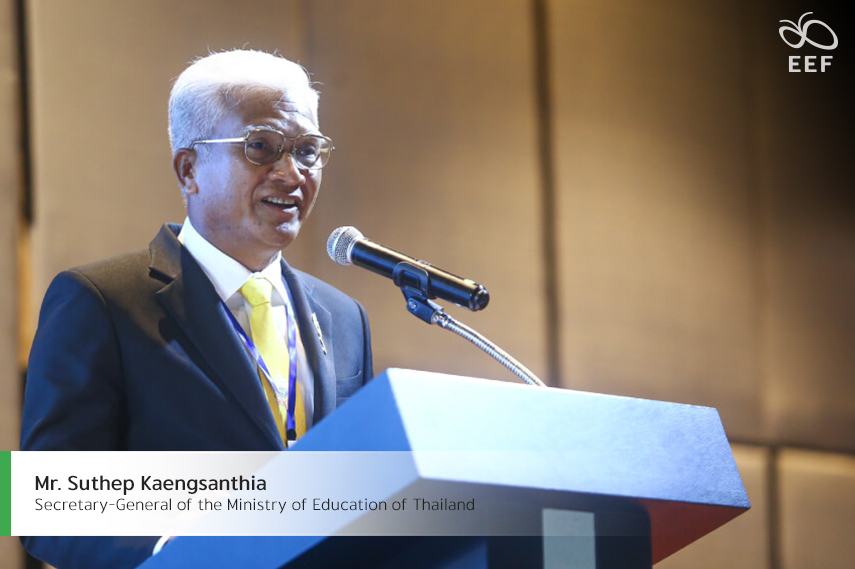
Mr. Suthep Kaengsanthia, Secretary-General of the Ministry of Education of Thailand, stated, “This meeting arises from a shared awareness of the importance of education in the region. Today, we find ourselves in a transition period marked by the losses incurred during COVID-19, as well as environmental issues leading to air pollution, global warming, and increasingly severe natural disasters. Additionally, rapid technological changes are affecting learning management. Therefore, we need urgent strategies to adapt our education management models to fit the context, ensuring that learning is diverse, flexible, and suitable for all groups and age ranges.”
“For Thailand, we are committed to developing education with sustainability in mind. This lifelong learning must prepare learners to cope with the complexities of the modern world, meaning education should serve as a foundation for improving quality of life and reducing inequalities in access to opportunities. However, to achieve these goals, we must exchange knowledge and experiences, present best practices, working models, and innovations, and share challenges with education professionals both within and outside the region. By doing so, we can adopt appropriate knowledge and methods, making our efforts more effective.”

Ms. Siri Jongdee, Deputy Director of the Equitable Education Research Institute (EEFI), participated in the panel discussion on “Financing for Education: Mobilizing Resources for Education,” where she summarized key points: “The allocation of education budgets and resources is a measurable indicator of how much each country prioritizes education, particularly regarding the proportion dedicated to the needs of vulnerable populations. The data shows that those lacking access to opportunities can remain in the education system only for a limited time. Therefore, equitable budget allocation must prioritize education in the early stages, from early childhood to primary education, to prevent underprepared children and youth from dropping out during secondary education.
The representative from EEF also addressed questions about “policy recommendations for fundraising to support education in Thailand,” stating that EEF works to reduce educational inequality by collaborating with the government to utilize data to enhance the effectiveness of state policies. Collecting comprehensive data on individual children and youth will aid in designing budget allocations that reach the most urgently needed target groups. For example, the Conditional Cash Transfer program gathers data from over 400,000 teachers nationwide to understand the barriers to learning faced by children and youth, including household income, health, welfare, and quality of life. Then, it uses this data to design appropriate resource allocations that address specific problems and needs.
“Economic measures help identify indirect income, known as PMT (Proxy Means Test), which serves as a mechanism to ensure the credibility of the screening process by allowing for the identification, prioritization, and assessment of ‘who’ needs assistance the most and what processes are suitable for the circumstances of each child and youth. Even though it is a grant program, it includes conditions covering attendance and monitoring development in various areas, ensuring that the funding will help children remain in the education system longer and provide opportunities for further education at higher levels.”
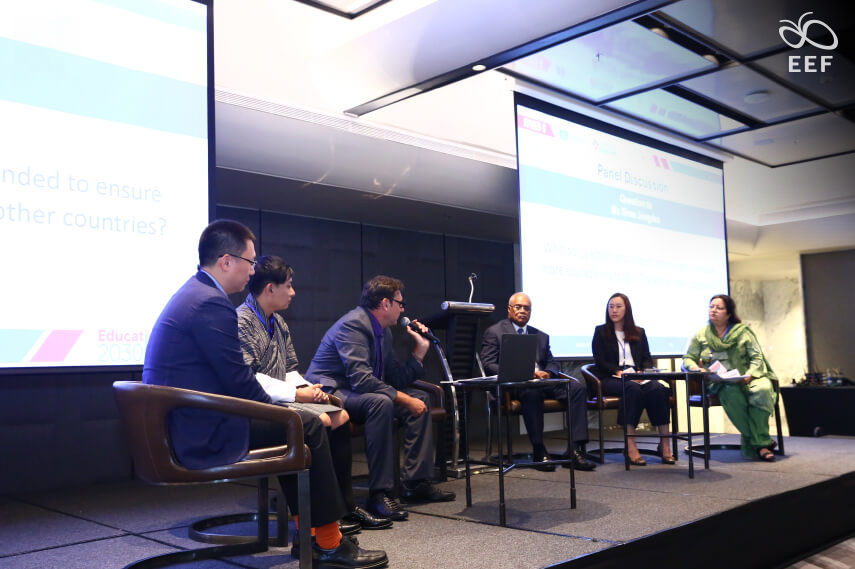
The Deputy Director of the Equitable Education Research Institute stated that using data as a foundation in the mission to reduce educational inequality also extends to children and youth who are not registered in the education system. EEF has collaborated with the government to compare the population register database with information on all children and youth listed in every educational jurisdiction, identifying those who have been overlooked. This information is then used to design processes for locating, assisting, and preparing for individualized learning. The various dimensions of this data will enable precise resource allocation, allowing for flexible and diverse learning options, as not all children and youth are equally prepared to return to school.
Before concluding the 6th Asia-Pacific Meeting on Education 2030 (APMED6), a summary of the approach to “transforming content and learning methods for a sustainable future” was presented. This approach prioritizes efforts to accelerate progress toward achieving SDG 4 by 2030, with a focus on enhancing foundational skills, numeracy, and social and emotional skills, which serve as the basis for all other learning, particularly for the most disadvantaged groups. It emphasizes flexible learning arrangements and lifelong learning pathways that connect learning to employment opportunities, improve efficiency, and reduce learning inequalities through digital tools. Additionally, it addresses the shortage of quality teachers and teacher training, promotes the teaching profession to attract younger generations, enhances teachers’ working environments, and supports continuous professional development for educators. The approach encourages educational collaboration among various agencies to create social partnerships that advocate for education policies and mobilize resources to expand learning opportunities from local communities to the regional level.
Ultimately, all countries in the Asia-Pacific region should ensure sufficient and equitable funding for education and lifelong learning, allocating at least 4-6% of GDP or 15-20% of total public expenditure for education. This is essential to meet international standards for sustainable education funding and to address inequalities in resource allocation by establishing policies focused on urgent areas. Leveraging collaborations among government, the private sector, local communities, and educational institutions is crucial to secure resources for equitable distribution. Furthermore, this approach should support educational innovation and expand successful operational models to a broader scale, ultimately paving the way for a more inclusive and sustainable future in education.
Outcome Document of 6th Asia-Pacific Meeting on Education 2030 (APMED 6):

